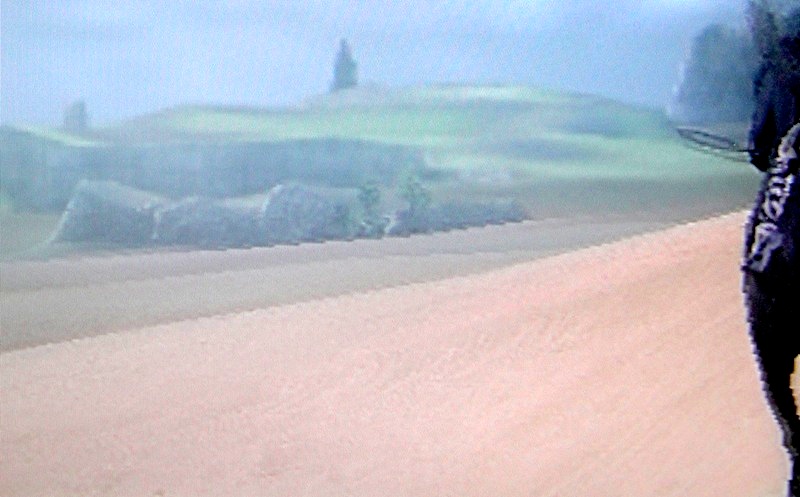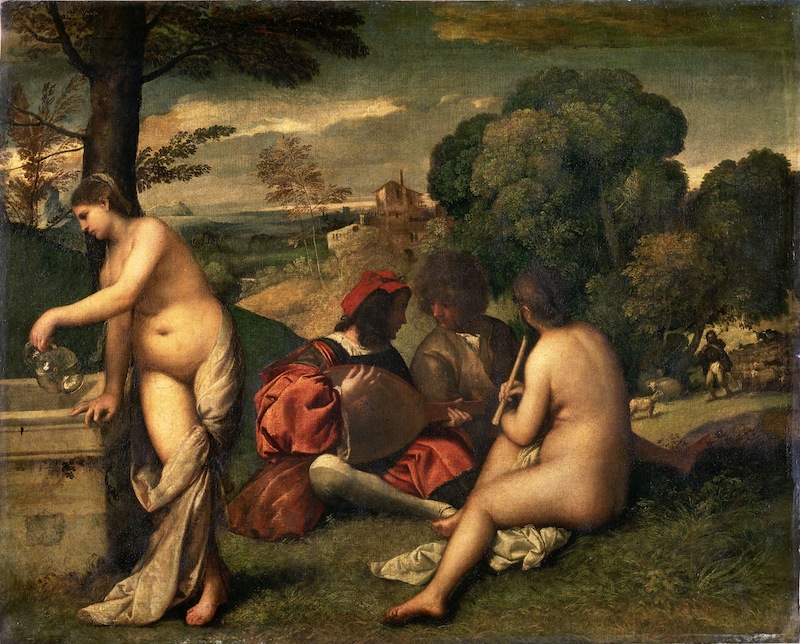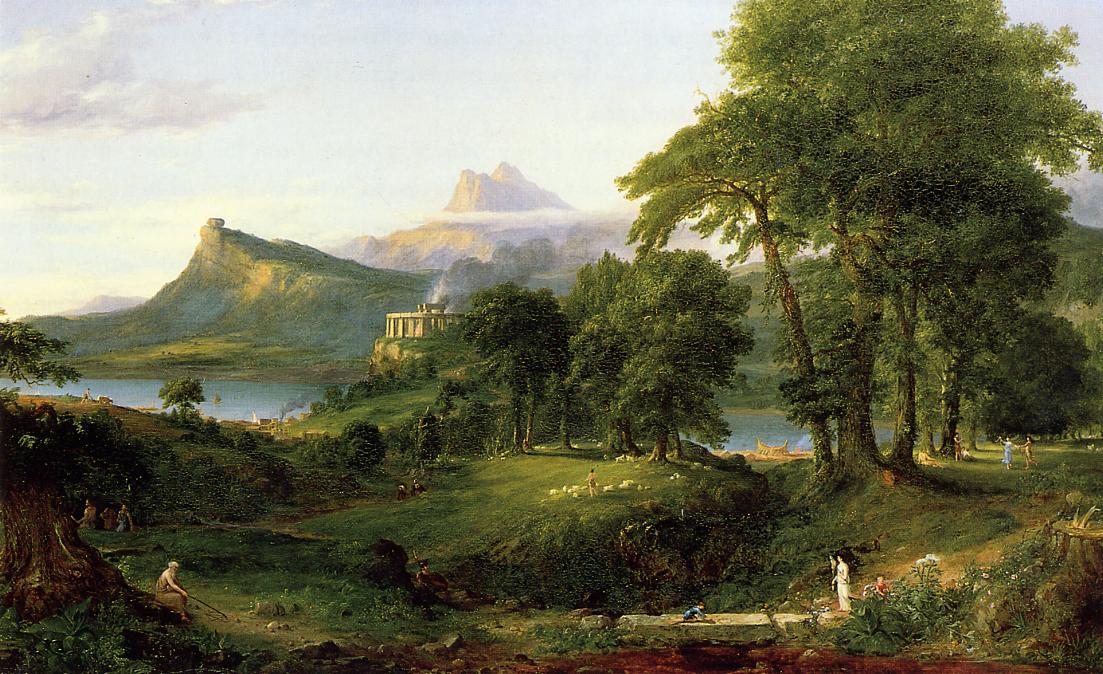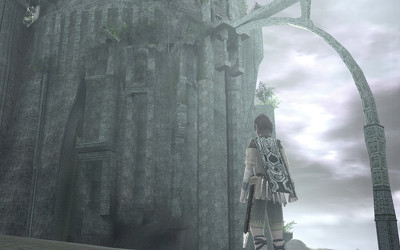The Virtual Pastoral
This paper was originally presented at the Converse College conference ‘Culturing the Popular’ in September 2010.
After Shadow of the Colossus was released for the PlayStation 2 in late 2005, I spent dozens of hours exploring its landscape. In comparison to other action/adventure videogames of its kind, these were relatively lonely hours. The geography of Shadow is sparsely populated—there is Wander, the game’s protagonist and player avatar, his horse Agro, the deceased maiden Mono, sixteen colossi, and a few odd birds and lizards. It’s an exercise in videogame minimalism—relatively little happens in-between Wander’s encounters with his monstrous adversaries. Many critics call it a videogame comprised solely of ‘boss fights.’ The creatures themselves serve as the game’s ‘levels,’ common game parlance for the playable game spaces that must be navigated from a designated beginning and end point, typically framed as distinct sections of a larger world.
When I returned to the game a few weeks ago in preparation for this paper, I was struck by my familiarity with the geography of the terrain after a five year leave. ‘The Forbidden Land,’ as it’s known in the game, is a fantasy world, though only due to the existence of the sixteen colossi. They vary in size and locomotion—one resembles a pterodactyl, another a shambling, hornless minotaur, another a massive sand serpent—yet they are all peculiar amalgamations of ruined architecture, fur, landscape, and machinery. They are like great earthen monuments brought to life.

Absent these creatures, the landscape is a realistic, if compressed, geography of rolling grasslands, dense patches of trees, small caverns, and expansive deserts, all etched with stone outcroppings and broken, moss-covered ruins of a past civilization. Along the world’s southern coast, for instance, jagged cliffs sprawl precariously above a fog-shrouded ocean. In the center of the in-game map, the massive Shrine of Worship, Wander’s architectural compass, juts into the sunlight at such a height that you can only take it in from a great distance. To the northeast, a narrow shadowed passage cuts between the mountain range, permitting only slender bands of refracted light to reveal its hidden waterfall.
The terrain is also conspicuously artificial. The cliffs are oddly faceted, betraying their underlying polygonal architecture. Up close, the grass and soil is coarsely textured with stretched graphic patterns, but also perfectly flat, evoking what New Yorker columnist Nicholson Baker recently called the ‘infinitely thin quilt of surface.’ The edges of stone and soil alike are hemmed with the tell-tale staircase of aliasing, wherein smooth curves or diagonal lines are approximated with multiple stacked lines of pixels. Character models slip into one another and themselves—Wander’s hair and tunic, for instance, frequently pass through other parts of his body, or worse, the surrounding terrain. The shroud of fog in the distance is as much technological constraint as aesthetic embellishment—fog is commonly used on the borders of videogame worlds to limit the quantity and complexity of graphics that need to be rendered in any given frame, especially if a world is ‘open,’ allowing a player to travel its entire breadth without a pause for loading. And all of these defects are compounded by the inevitable march of technology—Shadow just missed the recent transition to HD displays, so its graphics suffer considerably from the higher resolutions of newer televisions.

Despite these shortcomings, Shadow of the Colossus maintains the hallmarks of a real landscape. I remember its contours as a real space, a space I occupied and explored over many hours. I remember it as well as visits to Versailles or Niagra Falls, similarly fantastic places that I traversed with my real body and in a similarly abbreviated duration (in fact, in far fewer hours).
Shadow of the Colossus is an ideal example of what I call the virtual pastoral. In terms of its visual style, it is almost an overly obvious example of the genre. But beyond its peaceful naturalism, Shadow illustrates a model of the pastoral that is only superficially concerned with setting. The virtual pastoral operates specifically as a spatial, temporal, and subjective engagement set apart from normative play or interaction within a videogame world. I want to touch on a just a few of these pastoral aspects today in hopes that it might enrich our experience and understanding of videogames both as readers and players.
But first, what is pastoral?
Historically, the pastoral is an ancient form of lyric poetry rooted in the conversation and song of shepherds watching over their flock, a style commonly attributed to Greek poet Theocritus. Other notable pastoral practitioners include Virgil, Petrarch, Spenser, Milton, and Pope. Early critics of the form emphasized both the rural setting of its subjects and their lives of leisure. Over the centuries, the term grew beyond shepherds to encompass all matters of rural living, romanticized notions of country simplicity, childlike innocence, and the contemplation of quiet spaces buffered from the encroachment of urban or industrial influence.

In contemporary literary criticism, these same values are often examined for their ironic or allegorical qualities, partly to provide descriptive focus to a term that threatens to slip into meaninglessness as it covers more and more ground, and partly to rebuff accusations that the pastoral is outdated, simplistic, or conventional. Thus, in contemporary criticism, the pastoral begins to reveal a greater literary complexity by betraying its “inherent” contradictions—for example, how the enduring stability of nature contrasts our human movement toward mortality, how pastoral works are primarily consumed by those who lack the life it portrays, how the ideal landscape cannot exist without the threat of its urban foil, and so on.
In his essay, “Pastoral Topoi,” David Rosand describes many of the contradictory tendencies of pastoral landscape paintings, most notably their ability to ‘offer a world that is not quite our own, a natural world that is not, an artificial construct that seems all nature.’ This language is certainly evocative of videogames, since many exhibit worlds that are similar to, but not quite like our own, but it’s important not to over-emphasize elements of visual representation in pastoral scenery. Part of the ‘artificial construct’ Rosand describes is defined by its temporal distance; the pastoral landscape invites the viewer to participate in a scene that is never fully within reach, either spatially or temporally. The pastoral appeals wholly to our imagination and its distance enacts what Rosand calls ‘a poetry of nostalgia for the unrecoverable.’

Rosand’s expression is an apt summation of Shadow’s subdued narrative structure. Wander’s entire purpose for entering the Forbidden Land is to resurrect Mono. He brings her to the Shrine of Worship, where he is directed by a disembodied deity to seek out and destroy sixteen colossi in hopes of restoring her life. The game provides no other motivation for his quest, nor do we know why Mono is dead, but Wander’s passion to recover what is unrecoverable drives him to obey. Ultimately, we discover that his intentions are misguided, as much nostalgia is. The colossi are actually guardians tasked to subdue the malevolent god in the Forbidden Land. Mono is resurrected, but Wander apparently dies, thus sacrificing his own life and virtue for the life of another.
There is an understandable impulse to describe Shadow of the Colossus, stylistically and thematically, as pastoral, despite its lack of shepherds or song. The idyllic setting, especially the small clusters of trees that Rosand marks as a defining pastoral characteristic, fits the conventional look of pastoral landscape. But the game’s narrative and mechanical structure (and by mechanical, I mean how the game plays and/or directs the player through its rules and programmed interactions) are specifically opposed to the pastoral form. Like most videogames, the normative mode of Shadow is goal-oriented, however minimal its execution may be. The colossi are meant to be slain and the controls are designed to facilitate this goal. There are commands to climb, roll, grip surfaces, equip and wield weapons, call and control your horse, crouch, swim and run. These are not actions of leisure, but an adaptive toolset for finding, traversing, and killing your foes.
Likewise, the landscape itself is never fully benign. In its narrative role, it is not a site of rest or leisure. Its moniker—the ‘Forbidden Land’—and the absence of any other humans or wildlife cast an eerie pallor over its scenic vistas. Nature without life sharply and suddenly exposes its artificiality. Each time you track and encounter a colossus, who tend to stay hidden until you physically provoke them, you have the distinct feeling of trespass, even remorse. In Rosand’s account, the ‘pastoral occasion,’ as he calls it, is set aside both spatially and temporally. It tends to be intimate, enclosed, a pleasant place of leisure, ease, and rest. In contrast, the quest to kill the colossi on their native ground is a disruption of space, framed by the pressure of dwindling time.
When you participate in the game’s normative play structure, you actually invoke the utter defilement of the pastoral occasion. The presence of the colossi inverts the safety of the pastoral by directly obstructing your quest—Mono will remain dead unless they are destroyed. As I noted before, the colossi are hybrid monstrosities, living landscapes that fuse both territory and ruins, organic and machinic qualities (Fumito Ueda, the game’s creative director, said he combined disparate elements, like ‘the front of a car or the surface of a building,’ to emphasize both the creatures’ familiarity and peculiarity). They bleed when Wander pierces them with his sword, but they jettison a spectral black substance that could be either oil or blood. In short, they embody a paradoxical tension of nature, architecture, and mechanism in a single organism.
In “Pastoral Landscape and Antiquity,” John Pinto calls the presence of ruins a ‘logical visual foil to the present perfections of the pastoral scene.’ Nature is a kind of temporal stasis, where time never encroaches, while the presence of ruins re-injects the reality of time and its decay. Nature may persist, but humanity cannot. This visual foil is made strikingly malevolent in the figure of the colossi; not only are they reminders of human mortality, they are capable of hastening our own death. Wander can be literally crushed by ruins; inversely, if he defeats the colossus, its body is returned to the landscape as ruin.
Though the reversals I’ve described disqualify Shadow’s narrative or mechanical elements from pastoral classification, that is largely because they follow the prescribed trajectory of mastery and goal-attainment common to the majority of videogames. But there is another mode of experience, set apart from normative expectations, that is more properly designated as pastoral. It is specifically an interstitial—or in-between—experience that functions as an interior deconstruction of Shadow’s narrative and mechanical trajectory. In other words, exploring the terrain outside of the constraints of the quest opens up a new experience of temporality, duration, and even meditation that is actually countervalent to the game’s intended structure. And there are, in fact, small concessions to this interstitial form of play built into the game itself.

For example, throughout the Forbidden Land, there are numerous small shrines that serve as save points. These are geographic anchors and resting spots for both Wander and the player, since a continuous play-through may take ten hours of more, depending on the player’s skill. They are also functionally nostalgic—literally, metaphorically, and technologically. When a player saves her game, a record is written to the PlayStation’s 8mb flash memory card. This process commits a timestamp and a location reference to memory, both of which may only be recalled after the save process. In other words, a player’s spatial and temporal orientation is only available as a recollection of a past transcription, a perpetual state of nostalgia subject to continual erasure and rewriting.
The shrines are also set apart from the lair of any colossi, never within. When Wander kneels before the shrine, a shimmering field surrounds him and persists until the save process is complete. If you return from the save screen, or load a previous save state, Wander is shown sleeping in that same protective force field until you press a button to wake him. The shrine marks a quiet, protected place amidst the imposing scope of the larger world. Wander can rest at this point for an infinite duration, yet paradoxically no diegetic or meta-game time passes. The save point that I loaded this past week was the same that I had left in state five years ago.
In “Meditative Spaces,” Eric Pankey describes pastoral poetry’s efforts ‘to slow time down, to hold it still, to condense it or stretch it or twist it, without diminishing its vitality or precariousness.’ This ‘meditative mode’ is a succinct distillation of the save shrines in Shadow of the Colossus and is contingent upon a space for reflection, set apart from the pressures of closure or completion. Indeed, the parenthesis of the save may be left open infinitely.
I want to emphasize here how deeply the pastoral is tied to the virtual. We might even say that all pastoral is virtual. First, in the sense that all pastoral is virtuous—related both to what is good and ‘natural,’ set apart from the corrupting influence of urban life. And second, it is virtual in its tangible sense. The landscapes of pastoral painting and poetry can only be entered via the imagination; the viewer can never actually enter the world depicted. Yet while these settings are not actual, they may be experienced as such. Videogames enact this virtuality of the pastoral in part through their computational structure. All videogame landscapes are mathematically-derived models of reality. They are inherently idealized since they must be described and rendered programmatically, in code. But the construction of artificial worlds is not exclusive to computers, as similar metaphors of space, time, and interaction are available in poetry, painting, and other fine arts. Videogames are just particularly adept at actualizing the experience of space.

In all cases, the virtual pastoral is concerned with dwelling, rather than the exhaustion of space, or its panoptic disclosure. The typical videogame world is a space designed for mapping and mastery, reinforced through gameplay rules that encourage exploration purely for the accumulation of objects hidden in predefined locations (for instance, collecting flags in Assassin’s Creed or stars in Super Mario Galaxy) or the saturation of the map quantitatively expressed as ‘completion percentage’ (e.g. Castlevania: Symphony of the Night). Exploration in Shadow is not tied to a meta-game reward. Many of its hidden beaches, caverns, and gardens are wholly vestigial, divorced even from the over-arching quest narrative. Discovering these spaces does not reveal an otherwise hidden landmark on the in-game map, nor are there any new combatants to face. They reward exploration solely with the satisfaction of discovery and dwelling.
I was fortunate that my neglected save was directly preceding Wander’s confrontation with the sixteenth and final colossus. At this point, Wander is free to be true to his name and simply explore. I walked and rode for a half hour or more, struck by the breadth and scope of the world. Unlike many videogames, there is no method of expedited travel—the world is consistent and connected, which means that you must either ride or walk from point to point. But freed from any narrative constraint, this task was neither tedious nor boring. The game exerts no pressure to complete Wander’s quest. There are no day/night cycles, no ticking clock, no high score to achieve. In these moments of interstitial time, when the game logic awaits your decision but never demands it, the virtual pastoral is most acutely felt.